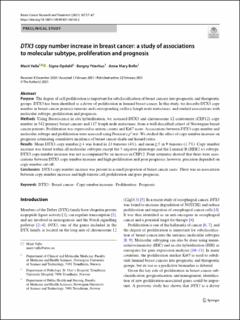| dc.contributor.author | Valla, Marit | |
| dc.contributor.author | Opdahl, Signe | |
| dc.contributor.author | Ytterhus, Borgny | |
| dc.contributor.author | Bofin, Anna M. | |
| dc.date.accessioned | 2021-09-24T06:48:07Z | |
| dc.date.available | 2021-09-24T06:48:07Z | |
| dc.date.created | 2021-08-10T16:58:57Z | |
| dc.date.issued | 2021 | |
| dc.identifier.citation | Breast Cancer Research and Treatment. 2021, 187 (1), 57-67. | en_US |
| dc.identifier.issn | 0167-6806 | |
| dc.identifier.uri | https://hdl.handle.net/11250/2781262 | |
| dc.description.abstract | Purpose The degree of cell proliferation is important for subclassifcation of breast cancers into prognostic and therapeutic groups. DTX3 has been identifed as a driver of proliferation in luminal breast cancer. In this study, we describe DTX3 copy number in breast cancer primary tumours and corresponding axillary lymph node metastases, and studied associations with molecular subtype, proliferation and prognosis. Methods Using fuorescence in situ hybridization, we assessed DTX3 and chromosome 12 centromere (CEP12) copy number in 542 primary breast cancers and 117 lymph node metastases, from a well-described cohort of Norwegian breast cancer patients. Proliferation was expressed as mitotic counts and Ki67 score. Associations between DTX3 copy number and molecular subtype and proliferation were assessed using Pearson’s χ2 test. We studied the efect of copy number increase on prognosis estimating cumulative incidence of breast cancer death and hazard ratios. Results Mean DTX3 copy number≥4 was found in 23 tumours (4%), and mean≥5 in 9 tumours (1.7%). Copy number increase was found within all molecular subtypes except the 5 negative phenotype and the Luminal B (HER2+) subtype. DTX3 copy number increase was not accompanied by an increase in CEP12. Point estimates showed that there were associations between DTX3 copy number increase and high proliferation and poor prognosis; however, precision depended on copy number cut-of. Conclusions DTX3 copy number increase was present in a small proportion of breast cancer cases. There was an associationbetween copy number increase and high tumour cell proliferation and poor prognosis. | en_US |
| dc.language.iso | eng | en_US |
| dc.publisher | Springer | en_US |
| dc.rights | Navngivelse 4.0 Internasjonal | * |
| dc.rights.uri | http://creativecommons.org/licenses/by/4.0/deed.no | * |
| dc.title | DTX3 copy number increase in breast cancer: a study of associations to molecular subtype, proliferation and prognosis | en_US |
| dc.type | Journal article | en_US |
| dc.type | Peer reviewed | en_US |
| dc.description.version | publishedVersion | en_US |
| dc.source.pagenumber | 57-67 | en_US |
| dc.source.volume | 187 | en_US |
| dc.source.journal | Breast Cancer Research and Treatment | en_US |
| dc.source.issue | 1 | en_US |
| dc.identifier.doi | 10.1007/s10549-021-06138-2 | |
| dc.identifier.cristin | 1925183 | |
| cristin.ispublished | true | |
| cristin.fulltext | original | |
| cristin.qualitycode | 1 | |

